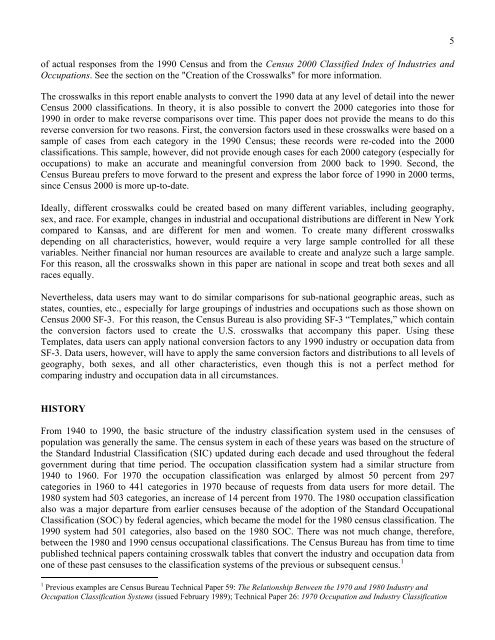The Relationship Between The 1990 Census and ... - Census Bureau
The Relationship Between The 1990 Census and ... - Census Bureau
The Relationship Between The 1990 Census and ... - Census Bureau
Create successful ePaper yourself
Turn your PDF publications into a flip-book with our unique Google optimized e-Paper software.
of actual responses from the <strong>1990</strong> <strong>Census</strong> <strong>and</strong> from the <strong>Census</strong> 2000 Classified Index of Industries <strong>and</strong><br />
Occupations. See the section on the "Creation of the Crosswalks" for more information.<br />
<strong>The</strong> crosswalks in this report enable analysts to convert the <strong>1990</strong> data at any level of detail into the newer<br />
<strong>Census</strong> 2000 classifications. In theory, it is also possible to convert the 2000 categories into those for<br />
<strong>1990</strong> in order to make reverse comparisons over time. This paper does not provide the means to do this<br />
reverse conversion for two reasons. First, the conversion factors used in these crosswalks were based on a<br />
sample of cases from each category in the <strong>1990</strong> <strong>Census</strong>; these records were re-coded into the 2000<br />
classifications. This sample, however, did not provide enough cases for each 2000 category (especially for<br />
occupations) to make an accurate <strong>and</strong> meaningful conversion from 2000 back to <strong>1990</strong>. Second, the<br />
<strong>Census</strong> <strong>Bureau</strong> prefers to move forward to the present <strong>and</strong> express the labor force of <strong>1990</strong> in 2000 terms,<br />
since <strong>Census</strong> 2000 is more up-to-date.<br />
Ideally, different crosswalks could be created based on many different variables, including geography,<br />
sex, <strong>and</strong> race. For example, changes in industrial <strong>and</strong> occupational distributions are different in New York<br />
compared to Kansas, <strong>and</strong> are different for men <strong>and</strong> women. To create many different crosswalks<br />
depending on all characteristics, however, would require a very large sample controlled for all these<br />
variables. Neither financial nor human resources are available to create <strong>and</strong> analyze such a large sample.<br />
For this reason, all the crosswalks shown in this paper are national in scope <strong>and</strong> treat both sexes <strong>and</strong> all<br />
races equally.<br />
Nevertheless, data users may want to do similar comparisons for sub-national geographic areas, such as<br />
states, counties, etc., especially for large groupings of industries <strong>and</strong> occupations such as those shown on<br />
<strong>Census</strong> 2000 SF-3. For this reason, the <strong>Census</strong> <strong>Bureau</strong> is also providing SF-3 “Templates,” which contain<br />
the conversion factors used to create the U.S. crosswalks that accompany this paper. Using these<br />
Templates, data users can apply national conversion factors to any <strong>1990</strong> industry or occupation data from<br />
SF-3. Data users, however, will have to apply the same conversion factors <strong>and</strong> distributions to all levels of<br />
geography, both sexes, <strong>and</strong> all other characteristics, even though this is not a perfect method for<br />
comparing industry <strong>and</strong> occupation data in all circumstances.<br />
HISTORY<br />
From 1940 to <strong>1990</strong>, the basic structure of the industry classification system used in the censuses of<br />
population was generally the same. <strong>The</strong> census system in each of these years was based on the structure of<br />
the St<strong>and</strong>ard Industrial Classification (SIC) updated during each decade <strong>and</strong> used throughout the federal<br />
government during that time period. <strong>The</strong> occupation classification system had a similar structure from<br />
1940 to 1960. For 1970 the occupation classification was enlarged by almost 50 percent from 297<br />
categories in 1960 to 441 categories in 1970 because of requests from data users for more detail. <strong>The</strong><br />
1980 system had 503 categories, an increase of 14 percent from 1970. <strong>The</strong> 1980 occupation classification<br />
also was a major departure from earlier censuses because of the adoption of the St<strong>and</strong>ard Occupational<br />
Classification (SOC) by federal agencies, which became the model for the 1980 census classification. <strong>The</strong><br />
<strong>1990</strong> system had 501 categories, also based on the 1980 SOC. <strong>The</strong>re was not much change, therefore,<br />
between the 1980 <strong>and</strong> <strong>1990</strong> census occupational classifications. <strong>The</strong> <strong>Census</strong> <strong>Bureau</strong> has from time to time<br />
published technical papers containing crosswalk tables that convert the industry <strong>and</strong> occupation data from<br />
one of these past censuses to the classification systems of the previous or subsequent census. 1<br />
1 Previous examples are <strong>Census</strong> <strong>Bureau</strong> Technical Paper 59: <strong>The</strong> <strong>Relationship</strong> <strong>Between</strong> the 1970 <strong>and</strong> 1980 Industry <strong>and</strong><br />
Occupation Classification Systems (issued February 1989); Technical Paper 26: 1970 Occupation <strong>and</strong> Industry Classification<br />
5
















